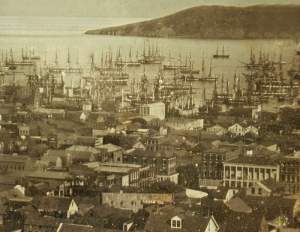Gold discovered in California at the beginning of 1848 helped change the fate of the union by encouraging an influx of white settlers in the final months of the 1840s and putting pressure on the federal government to admit the former Mexican province as a new state. The intense sectional debate over slavery made the decision over California statehood an explosive one ultimately leading to the national Compromise of 1850. James W. Marshall was the man who made the initial gold discovery on January 24, 1848 at John Sutter's Mill in northern California (near present-day Sacaramento). Marshall was a native of New Jersey and a veteran of the Mexican War who worked for Sutter. The discover soon became public and the rapid expansion of gold mining eventually drew more than 500,000 prospecters and opportunists to California. The "gold rush" became a cultural symbol of a new age. Yet major gold mining in California died out quickly and major gold operations ceased by the end of the Civil War. James Marshall, the original prospecter, received some fame for his discovery but made little money from his find and died in poverty in 1885. (By Matthew Pinsker)
Note Cards
Events
People
Places
Documents
Images
Bibliography
| Chicago Style Entry | Link |
|---|---|
| Helper, Hinton Rowan. The Land of Gold: Reality Versus Fiction. Baltimore, 1855. | View Record |
| Holliday, J. S., and William Swain. The World Rushed In: The California Gold Rush Experience. New York: Simon and Schuster, 1981. | View Record |
| Holliday, J. S. Rush for Riches: Gold Fever and The Making of California. Berkeley: University of California Press, 1999. | View Record |
| Hume, Janice, and Noah Arceneaux. “Glittering Dust, Dormant Treasure: Press, Public Memory and Georgia's 'Forgotten' Gold Rush.” American Journalism 23, no. 4 (2006): 7-33. | View Record |
| Richards, Leonard L. The California Gold Rush and the Coming of the Civil War. New York: Alfred A. Knopf, 2007. | View Record |
| Stillson, Richard T. Spreading the Word: A History of Information in the California Gold Rush. Lincoln: University of Nebraska Press, 2006. | View Record |











